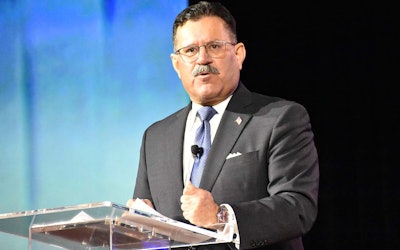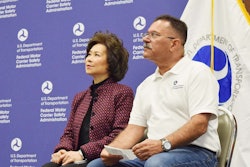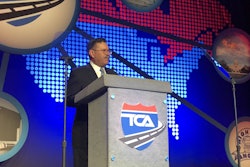 Martinez said carriers need to transition from AOBRDs to full-fledged ELDs as soon as possible, noting the agency does not want to extend the deadline. “I don’t want to see in the last few months of 2019 a push for, ‘Hey, we need an extension on moving to ELDs,’” he said. “I really think that uncertainly is not helpful for anybody.”
Martinez said carriers need to transition from AOBRDs to full-fledged ELDs as soon as possible, noting the agency does not want to extend the deadline. “I don’t want to see in the last few months of 2019 a push for, ‘Hey, we need an extension on moving to ELDs,’” he said. “I really think that uncertainly is not helpful for anybody.”At the Omnitracs Outlook user conference on Feb. 25 in Dallas, the administrator of the Federal Motor Carrier Safety Administration, Ray Martinez, said the agency is moving closer to proposing a rule to change federal hours of service regulations. He also urged carriers to transition from automatic onboard recording devices (AOBRDs) to fully compliant ELDs well ahead of the December 16 deadline, noting the agency doesn’t want to delay the compliance date.
“I don’t want to see in the last few months of 2019 a push for, ‘Hey, we need an extension on moving to ELDs,’” he said. “I really think that uncertainly is not helpful for anybody.”
Martinez’s comments on hours stopped short of an official public announcement that the agency will publish a notice of proposed rulemaking intended to overhaul hours of service regulations. He did not offer any insight as to what the rule will entail.
In August 2018, the agency published an advanced notice of proposed rulemaking (ANPRM) to ask for input on how the agency could add more flexibility to the HOS rules without compromising safety. FMCSA coupled the ANPRM with listening sessions across the country.
The FMCSA has not made changes to the HOS rules since 2003. Now that the trucking industry is complying with the electronic logging device (ELD) rule, the agency has been receiving data from motor carriers that “highlights areas in the current existing hours-of-service regulations that we may need to adjust or improve,” said Ray Martinez. “Now that’s a good thing.”
“If we are going to get the benefit of ELDs, we should be able to look at some fundamental changes in the hours of service that have really not been looked at in 15 years,” Martinez said to an audience of more than 800 attendees at the Hilton Anatole resort.
The agency received over 5,200 specific comments for the ANPRM. The quantity and the quality of the comments “were excellent and really informed the agency,” he said.
“I can’t announce anything today, but I will say given the great feedback and quality of the comments received from industry and stakeholders and safety advocates we are very, very excited about moving forward,” he said.
Martinez did not share any details of what the NPRM would contain but stated nothing has been sent to the Office of the Secretary of Transportation nor to the Office of Management and Budget (OMB) for review. Those two agencies must approve any rulemakings from FMCSA before they’re published.
Martinez indicated the NPRM when developed is likely to have some changes the trucking industry asked for.
Based on Martinez’ comments, sleeper berth options appears the most likely to be granted more flexibility in a forthcoming NPRM.
In 2017, FMCSA announced plans to do a three-year study on allowing drivers to split their on- and off-duty time into segments. The study was canceled after the agency received “excellent quantitative and qualitative information” on the subject from the industry, he said.
Martinez also announced FMCSA is finalizing an ANPRM that will seek input from the industry on adopting Advanced Driver Safety (ADS) systems. The agency wants input for vehicle inspection protocols, human-system interaction and workforce issues, among other areas for new vehicle technology.
“The key is to support innovation and technology in this industry going forward,” he said.
Relative to transitioning from AOBRDs to ELDs, one reason why fleets are postponing the process is the new ELD rule requires that drivers be given the option to accept or reject edits made by companies to their log records.
Ray Greer, chief executive of Omnitracs, said that currently only 10.7 percent of its customers that are required to be compliant with the ELD mandate have converted from AOBRDs.
“Our customers have effectively kicked the can down the road due to the complexities of making the change and the productivity impact,” he said. “You cannot put this thing off any longer.”
Over the last 12 months, Omnitracs has invested about 200 man-years of development to satisfy the ELD law. The development has increased the amount of line code by about 47 percent.
“It was a massive undertaking,” he said. “We are ready to go and ready to work with clients. Every chance I get I am pounding this drum with CEOs, telling them to ‘please work on this to drive the transition. It is very critical.”
Another work in progress at the FMCSA is the new scoring model for its Compliance, Safety, Accountability (CSA) program. Martinez says the new model, based on the IRT scoring method for violations, should be in place by the end of 2019.
He also mentioned the status of the crash preventability pilot program that allows carriers to dispute accidents on their records they were not their fault. The pilot program concludes in August 2019 and the plan is to move it towards full implementation.
“I think 2019 is going to be a very big year for that,” he said.











